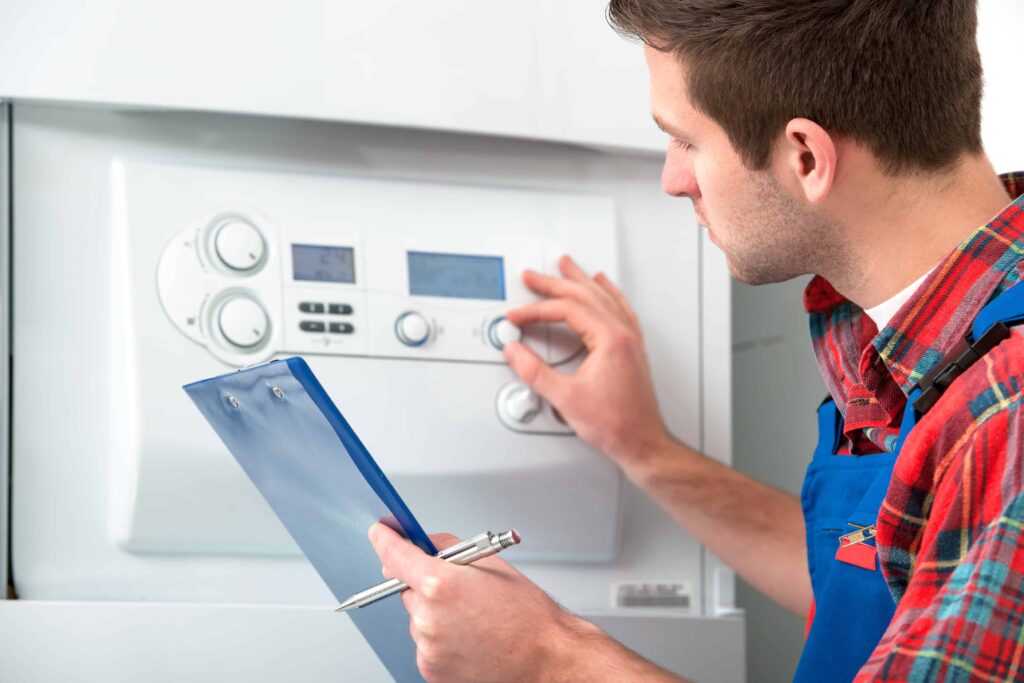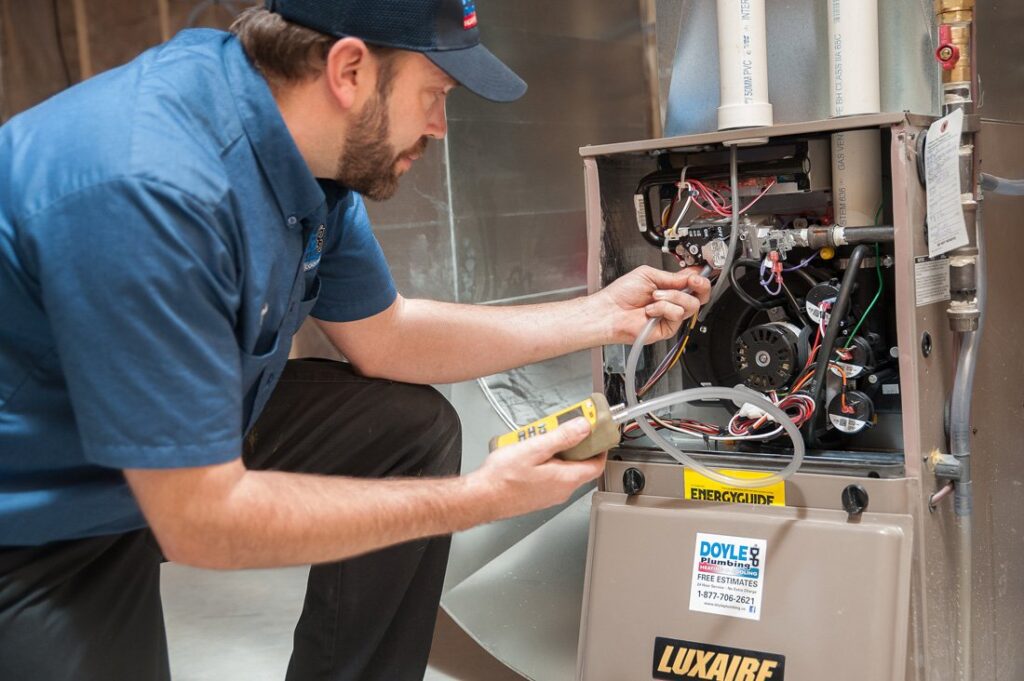Heating and cooling systems are found in most homes today and are used to maintain a comfortable temperature year-round. These HVAC systems move heat from one place to another using furnaces, boilers, air conditioners, or heat pumps. Your home’s heating and cooling system depend on what fuel source it uses (natural gas, oil, or propane), how it circulates air inside the house and how much energy it requires. In this article, we’ll look at each type of heating/cooling system available today and explain how they work so that you can make an educated choice when choosing which one will best suit your needs!
Heating and cooling systems are designed to keep your home comfortable by maintaining an even temperature.
The term “heating and cooling system” refers to maintaining a comfortable temperature in your home. These systems use air conditioning, heat pumps, or furnaces to regulate your home’s temperature by extracting or adding heat.
A heating and cooling system can be broken down into four parts:
- The outside unit (or condenser) contains fans moving air through an evaporator coil with cold refrigerant gas. This causes water vapour in the mood to turn into liquid water due to the low pressure from the compressor’s suction side, which draws it through a filter assembly before entering a compressor motor for compression and then returning it through another set of valves into another section called an expansion valve where it expands back into a gas before being routed back where it came from – outside!
There are three types of heating and cooling systems.
There are three types of heating and cooling systems commonly used in homes. The most common is a furnace, which heats air and sends it throughout your home through ductwork. The second option is a heat pump, which uses refrigerant to move heat from one place to another rather than just converting electricity into heat as a furnace does. While not as popular as furnaces or heat pumps, many homeowners still use boilers because they can simultaneously provide heating and hot water.
Heating works by transferring energy from the heat source to the space that needs to be heated.
The heat source is usually a furnace, boiler, or heat pump. The area that needs to be heated is typically a room or part of a room.
Heat transfer occurs by conduction, convection, and radiation. Conduction: thermal energy moves from solid objects (like pipes) through their material into another thing (like water). Convection: causes airflow in an area; convection currents move heat around your home. Radiative heat transfer: radiant energy is emitted by one object and absorbed by another; all things emit radiant energy at some point depending on their temperature level
Cooling works by transferring energy from the space that needs to be cooled to a more relaxed body.
Cooling works by transferring energy from the space that needs to be cooled to a more relaxed body. This can be accomplished by using either central air conditioning or window units.
Central air conditioners use a system of ducts and blowers to circulate air throughout the house, while window units draw in room-temperature air from outside your home and cool it with an electric element inside the unit before blowing it back into your home.

Regular maintenance makes for efficient heating and cooling system which keeps you and your family comfortable.
Regular maintenance is key to keeping your HVAC system working well. Have a professional inspect and clean your system every one to two years.
If you notice a drop in heating or cooling performance, have a professional check the system.
Heating and cooling systems provide comfort, but we need them to maintain them.
Heating and cooling systems are essential to our comfort. Without them, we wouldn’t be able to maintain a safe and comfortable temperature inside our homes. However, they’re not always easy to maintain. Heating and cooling systems need regular maintenance to keep them running efficiently. They also need to be serviced by trained professionals on how they work.
HVAC systems make your home warm in the winter and cool in the summer.
Heating and cooling systems work to make your home warm in the winter and cool in the summer. These systems are designed to keep your home comfortable by maintaining an even temperature year-round. There are three types of heating and cooling systems commonly used in homes:
- Forced air furnaces
- Central air conditioners
- Heat pumps
Heaters comprise furnaces, heat pumps, boilers, and radiators.
Furnaces use natural gas as their primary fuel source, although some furnaces can also be powered by oil or propane. These heaters burn fuel to heat air that flows into the home through ducts in the walls. When there’s no more air flowing out than pouring in (usually because it’s wintertime), these systems shut off automatically to prevent excessive heating and energy loss.
Heat pumps work similarly but turn electricity into heat instead of burning fossil fuels like gas or oil to produce it.
Furnaces are the most common type of heater used in homes with forced air heating systems.
If you are looking for a heater for your home, the most common type will be a furnace. Furnaces can be powered by gas, oil, or propane. The way that these types of heaters work is by using forced air to heat your home. An electric motor powers an electric fan that blows air through the ductwork throughout your house. A heat exchanger transfers heat from the gas or oil flame into hot air within the furnace to warm it before it enters your home’s ductwork system, where it heats other rooms in your house.
Furnaces use natural gas as their primary fuel source, although some furnaces can also be powered by oil or propane.
- Furnaces are used in homes with forced air heating systems.
- The furnace has two main parts: the blower and the heat exchanger or burner assembly. The blower circulates air throughout your home while the heat exchanger converts combustion gases into heat.
A furnace’s main job is to produce enough heat for your home to stay comfortable during cold weather.
Furnaces are typically used in homes with forced-air heating systems but can also be found in hydronic (hot water) methods. Forced air furnaces have a blower that pushes warm air through ducts throughout the house and returns it to the stove. Hydronic systems use pipes filled with hot water heated by a water heater on its way through the house.
A furnace converts combustion gases into heat through a series of metal tubes heated by burning gas called the “heat exchanger.” The gas is then pushed into what is known as an inducer motor that turns it into hot air. The warm air then enters your ductwork or registers, depending on how many rooms you want to be heated at once, where it heats up via convection currents caused by fans blowing across them.

Furnaces convert combustion gases into heat through a series of metal tubes heated by burning gas called the “heat exchanger.”
Natural gas is primarily used as a fuel source in furnaces because it’s cheap, readily available, and burns cleanly.
What happens to natural gas when you turn on your furnace? The gas heats up inside the burner chamber, causing it to expand rapidly in volume and increase its temperature. As a result, this hot air begins moving through a “burner throat” opening before entering what’s known as a “secondary combustion chamber.” Inside this area lies an ignition device that uses electricity to ignite the natural gas coming through the burners so they can be heated up again at high temperatures required for efficient heating (around 1350 degrees Fahrenheit). At this stage, water vaporized from incoming cold air mixes with other gases from secondary combustion chambers, creating vast amounts of energy needed to provide hot air throughout your home or office building during winter.
Heat pumps are HVAC system that uses electricity to move hot or cold air inside your home instead of using a furnace or air conditioner.
Heat pumps work by moving heat from one place to another. They do this by taking in warm air from outside and transferring it into your home, where it heats the inside. Then they take out any excess heat and send it back through some ducting system (also known as “exhaust”).
Heat pumps are different from traditional furnaces because they can both fabulous and dehumidify the air simultaneously—furnaces only do one thing at a time: either cool down the house or heats its inhabitants’ blood pressure levels! This makes them more efficient than other systems because they don’t just have one function; they can perform multiple roles simultaneously depending on what needs attention most urgently (i.e., adding more warmth during winter or reducing humidity levels during summer months).
A boiler is part of central heating in homes with radiators rather than forced-air systems.
A boiler is a device that heats water and can be used to warm the water in your home. A boiler can also heat the water in your pool if you have one.
Boiler systems are often used as part of central heating systems in homes with radiators rather than forced-air systems.
Unlike furnaces, boilers create heat through steam instead of combustion gases, and they do not require ductwork as heat pumps and furnaces do.
Unlike furnaces, boilers create heat through steam instead of combustion gases, and they do not require ductwork as heat pumps and furnaces do. Boilers are used in homes with radiators to provide hot water or space heating. Because these systems are more efficient than furnaces, they’re often used for larger homes and apartments where there is a greater need for space heating or hot water.
Heating and cooling systems help maintain safe and comfortable temperatures inside your home year-round.
Heating and cooling systems are essential to maintaining a healthy home. Without them, the temperature inside your home could be too hot or too cold for you, your family, and your pets to live comfortably. However, because heating and cooling systems are crucial for keeping your house safe and comfortable, they’re critical to maintaining them properly.
When it comes time for maintenance of your HVAC system, it’s vital that you trust only licensed professionals from companies like Sarman Air Company. It is a Thornhill-Based HVAC company offering complete Heating and Air Conditioning installation and services to the GTA. . The professionals at Sarman Air understand that these appliances can be complex and dangerous if misused or incorrectly installed. They can also help you determine whether it might be time for replacement rather than repair!
Heating and cooling systems are an essential part of modern life. They help keep us comfortable during hot and cold temperatures, which is why they’re so popular today. However, they can also be costly if you don’t regularly keep them. Make sure you schedule routine checkups with a Sarman Air professional to ensure your system is operating efficiently!



